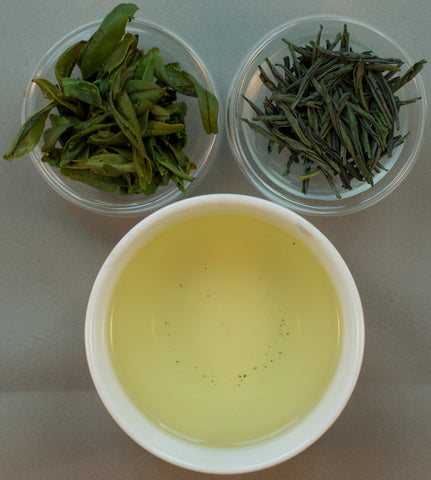Gyokuro (“Jade Dew”) gets its name from its intense green color and the historical ball-shaped preparation of this tea. Nowadays, the leaves are straight needles like sencha, but the shading process prior to harvest still gives the tea its deep, saturated green color and rich umami flavor.
The Yame growing region is known across Japan for its excellent Gyokuro. Production of Gyokuro involves a 10-day period of shading the tea plants prior to harvest. The shading forces the plant to boost its chlorophyll and L-theanine production and retain its store of amino acids, leading to a deep green color and rich umami.
This is a Dento Hon Gyokuro (伝統本玉露), meaning it must be grown in Yame, Fukuoka (similar to the regional protection accorded to champagne, Parmigiano-Reggiano, etc.), the plants must be grown naturally, must be traditionally shaded for at least 16 days with tana (棚), a tent-like cover made from straw, and, finally, all Dento Hon Gyokuro is handpicked by farmers. Less than 1% of gyokuro produced in Japan is Dento Hon.
Provenance:
-
Origin: Hoshino Village, Yame, Fukuoka, Japan
-
Grower: Hoshino Seicha
-
Elevation: 200m~300m
-
Harvest Date: May 2023 (Single Harvest)
-
Cultivar: Yabukita & Sae Midori
-
Cultivation: Natural
-
Plucking Standard: Machine
-
Processing Notes: Asamushi (light steamed)
-
Nickname: shizuku (雫) means "dewdrop," so this could be more specifically called "Jade Dewdrop."
-
History/Pedigree: Developed in 1835 by Yamamoto Kahei in Uji, Kyoto, Japan, Gyokuro became the first shaded tea in Japan to be consumed as a loose leaf tea. The original Gyokuro was called “Tama no Tsuyu” and involved the leaves being curled into tight balls, but through the years, this tea came to be processed like Sencha, with the familiar needle-shaped leaves.
Brewing Suggestions1:
-
Water: 120-160˚F
-
Tea: 2g per 4oz of water (a level 1 tsp2)
-
Steep: 1-2 minutes, infuse up to 4 times or until steeped out
Tasting Notes:
- rainforest aroma accompanied by a strong umami sweet pea flavor, with a thick, luscious mouthfeel
1 Brewing suggestions are just that. Try it the suggested way then experiment. In this case I suggest first experimenting with the quantity of tea per oz of water. I actually use 4g per 4oz of water as I like the stronger flavor of a higher tea to water ratio, especially for gyokuro. For temperature, you can try it as low as 120˚. Some tea drinkers like to use slightly hotter and longer times for each subsequent steeping.
2 Weighing your tea is always the best way to control your dosage. I provide approximate volume measures for convenience but they can be problematic due to the variance in tea leaf shape and size. gyokuro actually works OK for volume measurements because of it’s small flat, needle shape



